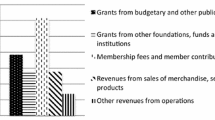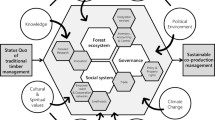Abstract
Forest owner cooperations (FOC) are bundling wood supply from small-scale forests and some also offer additional services, such as wood harvesting or planting. FOCs are growing throughout Europe in terms of the managed timber volume. The increasing timber demand of forest-based industries as well as the new, rapidly growing demand for energy plants could lead to an under-supply in the following years in Europe. Because of high harvesting arrears in small-scale forests, FOCs are seen as an opportunity to overcome this foreseen timber shortage. The paper maps out timber mobilisation strategies using the SWOT (Strengths, Weaknesses, Opportunities and Threats) approach.
Similar content being viewed by others
Notes
In Austria forest possession with more than 200 ha is called forest enterprise, while smaller ones are called small-scale forests.
References
Andrews K (1980) The concept of corporate strategy, 2nd edn. Irwin Homewood, IL
Anonymus (1999) Strategische Positionierung forstlicher Zusammenschlüsse in Österreich. Eigenverlag 8
Anonymus (2001) Waldbesitzervereinigung Kempten: Regionale Wirtschaftskreisläufe mit Holz am Fuß der Alpen. In: Stärke durch Kooperation. Erfolgreiche Forstwirtschaft im Kleinprivatwald. Holzabsatzfond 4–7
Bartol K, Martin D (1998) Management. 3rd edn. Irwin McGraw-Hill, Boston, pp 223–226
Baumgartner DM, Creighton JH, Blatner KA (2003) Use and effectiveness of washington state’s extension forest stewardship program. Small-scale Forest Economics. Manage Policy 2(1):49–61
Bundesamt und Forschungszentrum für Wald (2004) Ergebnisse der Österreichischen Waldinventur 2000–2002. Available at http://www.web.bfw.ac.at/i7/oewi.oewi0002
De Galembert B (2003) Wood supply for the growing European pulp and paper industry. Seminar on strategies for the sound use of wood. Poiana Brasow, Romania, 24–27 March 2003. Available at http://www.unece.org/trade/timber/docs/sem-1/papers/r4Galembert.pdf
Dyson RG (2004) Strategic development and SWOT analysis at the University of Warwick. Eur J Oper Res 152:631–640
Einsiedler I (2000) Auf dem Weg in die Zukunft: Waldbesitzervereinigung Kempten, Land und Stadt e.V. AFZ/Der Wald 12:612–614
Hogl K, Pregernig M, Weiß G (2005) What is new about new forest owners? A typology of private forest ownership in Austria. Small-scale forest economics. Manage Policy 4(3):325–342
Houben G, Lenie K, Vanhoof K (1999) A knowledge-based SWOT-analysis system as an instrument for strategic planning in small and medium sized enterprises. Decis Support Syst 26(2):125–135
Jacobson M (2002) Ecosystem management in the Southeast United States: interest of forest landowners in joint management across ownerships. Small-Scale Forest Economics. Manage Policy 1(1):71–92
Kiosowski R, Stevens T, Kittredge D, Dennis D (2001) Economic incentives for coordinated management of forest land: a case study of southern New England. For Policy Econ 2:29–38
Kohlöffel KM (2000) Strategisches management. Carl Hanser Verlag, München, pp 262
Kotler P (1998) Marketing management: analysis, planning, implementation and control. 6th Edn., Prentice-Hall, Upper Saddle River
Kurttila M, Pesonen M, Kangas J, Kajanus M (2000) Utilizing the analytic hierarchy process (AHP) in SWOT analysis—a hybrid method and its application to a forest-certification case. For Policy Econ 1(1):41–52
Lobriser R, Abplanalp PA (1998) Strategisches Management. Visionen entwickeln. Strategien umsetzen. Erfolgspotentiale aufbauen. Versus, Zürich, p 468
Maier G (1995) Analyse der Beschaffung von Rundholz in der Sägeindustrie Österreichs. Dissertation an der Universität für Bodenkultur Wien, p 219
Ni Dhubhain A, Kavanagh T (2003) Joint ventures in private forestry in Ireland. Small-scale Forest Economics. Manage Policy 2(1):9–19
Oswald K, Riechsteiner D, Thees O, Lemm R (2004) Reorganisation of wood production for improved performance: a Swiss forest district case study. Small-scale Forest Economics. Manage Policy 3(2):143–160
Pesonen M, Kurttila M, Kangas J, Kajanus M, Heinonen P (2001) Assessing the priorities using A’WOT among resource management strategies at the finnish forest and park service. For Sci 47(4):534–541
Prahalad CK, Hamel G (1991) Nur Kernkompetenzen sichern das Überleben. Harv Manager 2:66–78
Rauch P (2002) Improving the business process for forest co-operations as first step to SCM. In: Kelogg L, Spong B, Licht P (eds) Proc Woodfor Africa 2002, Forest Engineering Conference, Forest Engineering Solutions for Achieving Sustainable Forest Resource Management. An International Perspective. CD ROM, 125–132. 3.7.2002, Pietermaritzburg, South Africa
Rauch P, Gronalt M (2005) Evaluating organisational designs in the forestry wood supply chain to support forest owners cooperations. Small-scale Forest Economics. Manage Policy 4(1):53–68
Rauch, Peter (2003) Strategien und Maßnahmen für eine effiziente KleinwaldbewirtschaftungSWOT Analyse, Prozessmanagement, GIS-gestützte Potentialanalyse und Organisationsentwicklung. Dissertation an der Universität für Bodenkultur, Wien, p 173
Rickenbach M, Guries R, Schmoldt D (2006) Membership matters: comparing members and non-members of NIPF owner organizations in southwest Wisconsin, USA. For Policy Econ 8(1):93–103
Romer M, Grebenstein T, Feneberg T, Brändle T (2000) Organisation, Struktur und Aufgaben eines forstlichen Zusammenschlusses. AFZ/Der Wald 55(12):615–619
Ruschko S (2002) Waldeigentümer in Österreich. Eine repräsentative Telefonumfrage. Diplomarbeit an der Universität für Bodenkultur, Wien, p 138
Saaty TL (1980) The analytic hierarchy process. McGraw-Hill, New York
Södra (2005) available at www.sodra.com, cited 14.11.2005
Sorensen L, Vidal R, Engström E (2004) Using soft OR in a small company—the case of Kirby. Eur J Oper Res 152:555–570
Stordal S (2004) Impacts of the European economic area agreement on the structure and concentration of roundwood sales in Norway. For Policy Econ 6(1):49–62
Waldverband (2004) Strategische Positionierung der Waldverbände in Österreich zur Mobilisierung von Holz. Available at http://www.waldverband.at/downloads/StrategiepapierFolder.pdf
Wheelen T, Hunger J (1995) Strategic management and business policy, 5th edn. Addison Wesley, Reading, pp 1194
Ziegenspeck S, Härdter U, Schraml U (2004) Lifestyles of private forest owners as an indication of social change. For Policy Econ 6(5):447–458
Author information
Authors and Affiliations
Corresponding author
Additional information
Communicated by Martin Moog.
Rights and permissions
About this article
Cite this article
Rauch, P. SWOT analyses and SWOT strategy formulation for forest owner cooperations in Austria. Eur J Forest Res 126, 413–420 (2007). https://doi.org/10.1007/s10342-006-0162-2
Received:
Revised:
Accepted:
Published:
Issue Date:
DOI: https://doi.org/10.1007/s10342-006-0162-2




